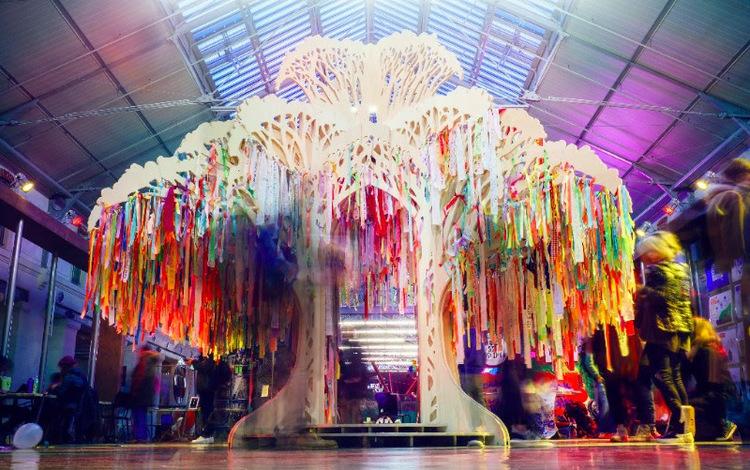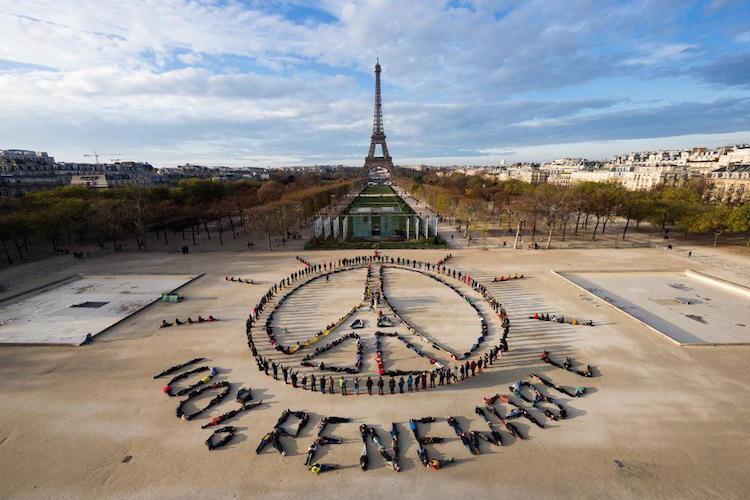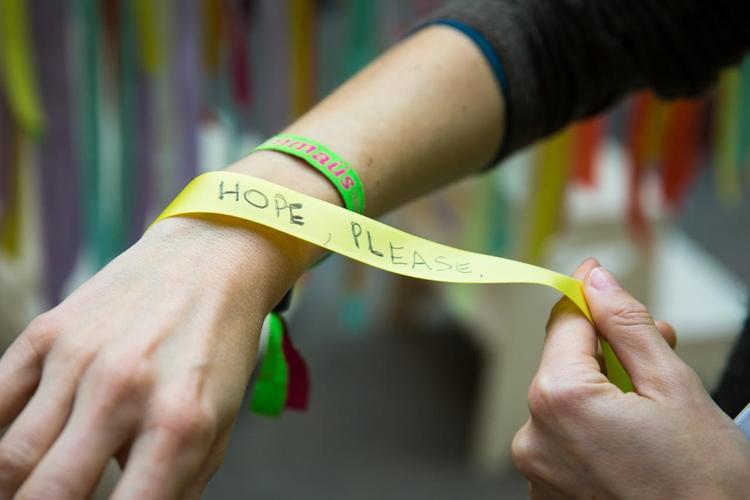
What do you Love and Hope to Never Lose to Climate Chaos?
Thoughtworkers in North America sent a message to the UN Climate Summit (COP21) in Paris last December by creating “Climate Ribbons” reminding negotiators what we stand to lose if a binding carbon-reduction treaty does not succeed. Their ribbons were part of a massive art installation that was central to events surrounding the UN Summit, called the Climate Ribbon, co-organized by Rae Abileah, a consultant on social justice strategy to Thoughtworks. Additionally, several Thoughtworkers traveled to Paris to take part in climate justice forums, to document protests on film, and to be a voice in the media. Following the COP21, Thoughtworks organized screenings of the new film on climate change, This Changes Everything in our offices around the world.
We asked this question and thousands of people told us their answers:
“Long walks in nature with loved ones.” — Kylie C, Thoughtworks San Francisco
“My children.” — Ryan M, Thoughtworks San Francisco
“Hummingbirds in my rainforest.” — Eric in San Cristobal, Chiapas, Mexico
“My father who grew up in an extremely polluted part of Detroit and is battling throat cancer.” — Mattie, Michigan, USA
“Le joie de vivre!” — Olga, Paris, 67
Thousands of ribbons were mailed, across the globe, to the UN Climate Summit (COP21) in December 2015, in answer to our question. We collected hundreds more at climate rallies and public events. We were can truly say that we were humbled, inspired, and motivated by the number of individual, personal messages we saw.
Amongst the thousands of ribbons that were displayed in Paris were contributions from Thoughtworkers in Chicago, New York City, and San Francisco. Despite not being able to physically attend the summit, their voices were represented.

Picture Credit: Josiah Werning
While negotiators were occupied hashing out humanity's future, a sprawling civil society mobilization was rising, with a call for a 100% renewable future and justice for all.
The Climate Ribbon project culminated in a massive tree sculpture, adorned with ribbons, which held these deeply personal messages from across the world. The tree was installed in the center of mobilization spaces across Paris, touring across the city. The tree became a central focal point, where people from all over the city came to connect, grieve and make a commitment to act in solidarity, beyond Paris.
Ribbon Exchange at the Eiffel Tower
One of the most memorable events came midway through the two-week talks, at a crucial moment when civil society was outraged and disappointed in the lack of momentum toward a binding agreement.
As the UN talks stuttered, the clamour of voices on the streets of Paris grew louder, and hundreds of people of myriad ages and cultures united under the Peace Wall at the base of the Eiffel Tower. There, they arranged themselves into a giant human banner spectacle to spell out a powerful demand to UN negotiators: 100% Renewable!

Picture Credit: Yann Arthus-Bertrand
This image has become a much-loved, viral, iconic image of the COP21 - and it was sparked by an exchange of ribbons.
As people entered the large square, they were greeted by Climate Ribbon volunteers holding large baskets of ribbons, and were invited to write their story of love and loss on a ribbon. On a nearby stage, people read their ribbons aloud in French and English. The growing crowd responded to each person, “We are with you!” Hundreds of participants then exchanged ribbons, helping each other tie them onto their wrists as a commitment to continue to take action after Paris. In this way, the Climate Ribbon set the mood for the event - reflective, somber, but also vibrantly unified and contagiously friendly.
Ribbons at the UN
The Climate Ribbon wasn’t just on the streets. We took thousands of messages written on ribbons from around the world directly to those closest to the negotiations.

Picture Credit: LJ Amsterdam
We connected with delegates, observers, climate campaigners, and media outlets from across the globe at Climate Generations - the civil society exhibition hall adjacent to the UN negotiation hall. Many of these attendees were immediately drawn to the tree and its invitation to reflect on our connection to nature, and each other.
We were determined to deliver Climate Ribbon stories directly to the hands of the negotiators, and we even handed a ribbon to President Hollande.
Why Emotion Matters
Event after event, we observed the profound effect that the tree and the ribbon ritual had on people: it was grounding, it set a tone and it stirred emotion. Families and children, in particular, were affected by the tree. We witnessed the project’s ability to excite and inspire when one of our volunteers guided three young French-Algerian children through the ritual. Too young to read, they picked out a ribbon just based on its color, and untied it from the tree. The volunteer read the ribbon to them: “Sean, 26, in London, does not want to lose ‘very big cats, and very small fish’.” The three children listened intently. And then she asked them: “Do you want to help Sean?” “Oui, yes!” they all said, nodding decisively.
Carl, aged 14, from Syria, wrote a climate ribbon that highlighted the deep connection between conflict and climate chaos, sharing how farmers have difficulty growing crops as temperatures rise, driving many to the cities, unemployed and hungry. For many families in Syria, he explained, the risk comes with every breath: "With the bombs, there is no electricity and with the pollution, the people can't breathe."
The Climate Ribbon aims to carry us past the paralysis that often comes from being aware of the sheer enormity of the work required to mitigate climate change. “Why up till now, has there been so little public action on climate change?” asks Gan Golan, one of the project’s co-founders. “It turns out, it may not be from a lack of awareness, but in some ways, because of it. When we try to absorb the full consequences of what is now happening — and the enormity of what is yet to come — we can easily become paralyzed. When we experience these feelings alone, the issue feels too big, the costs too difficult to grapple with,” adds Golan. “Instead of being spurred to action, we often turn away.”
“But,” says Andrew Boyd, co-founder of the Climate Ribbon project, “when we create a safe container to go through these feelings collectively, together with others, something different happens. Instead of holding the feelings in, we let them out. Instead of isolation, we can find solidarity. Instead of powerlessness, we find empowerment. Instead of resignation, we pave a way toward action.”
Drawing Red Lines, Demanding Justice
On the final day of the COP21 activists created a massive red line down one of the main boulevards radiating from the Arc du Triomphe, symbolizing the red lines that negotiators mustn’t cross to preserve a habitable planet for life as we know it. In a beautifully choreographed mass action, people popped up red umbrellas and held up red tulips, symbolizing the lives lost to climate injustice. Rae Abileah, a consultant on social justice strategy to Thoughtworks and co-creator of the Climate Ribbon project, was interviewed on Democracy Now! reading ribbons she draped over the long red line of tulips, in what became a live street art altar. A spontaneous march broke out and snaked through the streets to the Eiffel Tower, as giant inflatable red lines bounced through the crowd.
While the jubilant march was claiming the streets, the UN negotiators were sealing the deal. A deal that, while heralded by many news headlines as a victory, fell short of the binding commitments needed to keep the planet cool enough to protect life as we know it, especially for communities most vulnerable to rising sea levels, toxic carbon emissions, and failing ecosystems.
But we know that the COP21 was only one step in a larger process, and that our fate will be determined not only by our governments, but by our own bold actions, strategic fossil fuel divestment campaigns, and fearless commitment to ensuring climate justice. If we fail to act now, we can visualise all the things written on ribbons -- from a granddaughter’s first apples to the the snow-capped mountains in the Congo -- disappearing forever.
We all have red lines. They run through our hearts, our communities and lives. What is your red line? What do you love and hope to never lose to Climate Chaos? And what will you do to take action so that the next COP doesn’t cross them?
The Climate Ribbon project continues in schools and communities around the world. You can support the project with your story, tech genius, organizing power or a donation. It will all be put to beautiful use to help further engage people on why we must act now.
Disclaimer: The statements and opinions expressed in this article are those of the author(s) and do not necessarily reflect the positions of Thoughtworks.














